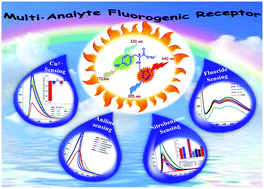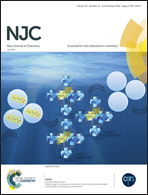Design and application of a fluorogenic receptor for selective sensing of cations, small neutral molecules, and anions†
Abstract
Based on the strategic design, we report here an unprecedented single-molecular multi-analyte fluorogenic receptor behaviour of the sodium salt of N-(methyl-2-thiophenyl)-L-tyrosine (NaHTyrthio), wherein it enables selective sensing of a cation (Cu2+), small neutral molecules (nitrobenzene and aniline) and an anion (F−) at the ppm or ppb level in aqueous methanol. The judicious interweaving of two fluorophores (phenol and thiophene) in NaHTyrthio is based on the fact that the emission wavelengths for the two fluorophores (phenol: 320 nm; thiophene: ∼440 nm) are well separated upon excitation at two different wavelengths (270 nm and 395 nm, respectively). Fluorescence quenching serves as a signal for the sensing of Cu2+ and nitrobenzene (attributed to the phenol part) along with F− (attributed to the thiophene part) while sensing of aniline is enabled by the shift in the emission wavelength of the phenol part of the receptor. To the best of our knowledge, this is the first time a single receptor has been developed to selectively detect a cation (Cu2+), neutral small molecules (nitrobenzene and aniline) and an anion (F−) using a single analytical technique. In each case, the nature and level of the receptor–analyte interactions are established through fluorescence lifetime measurements, NMR titration experiments, and the calculation of the quenching constants from the Stern–Volmer plots.



 Please wait while we load your content...
Please wait while we load your content...